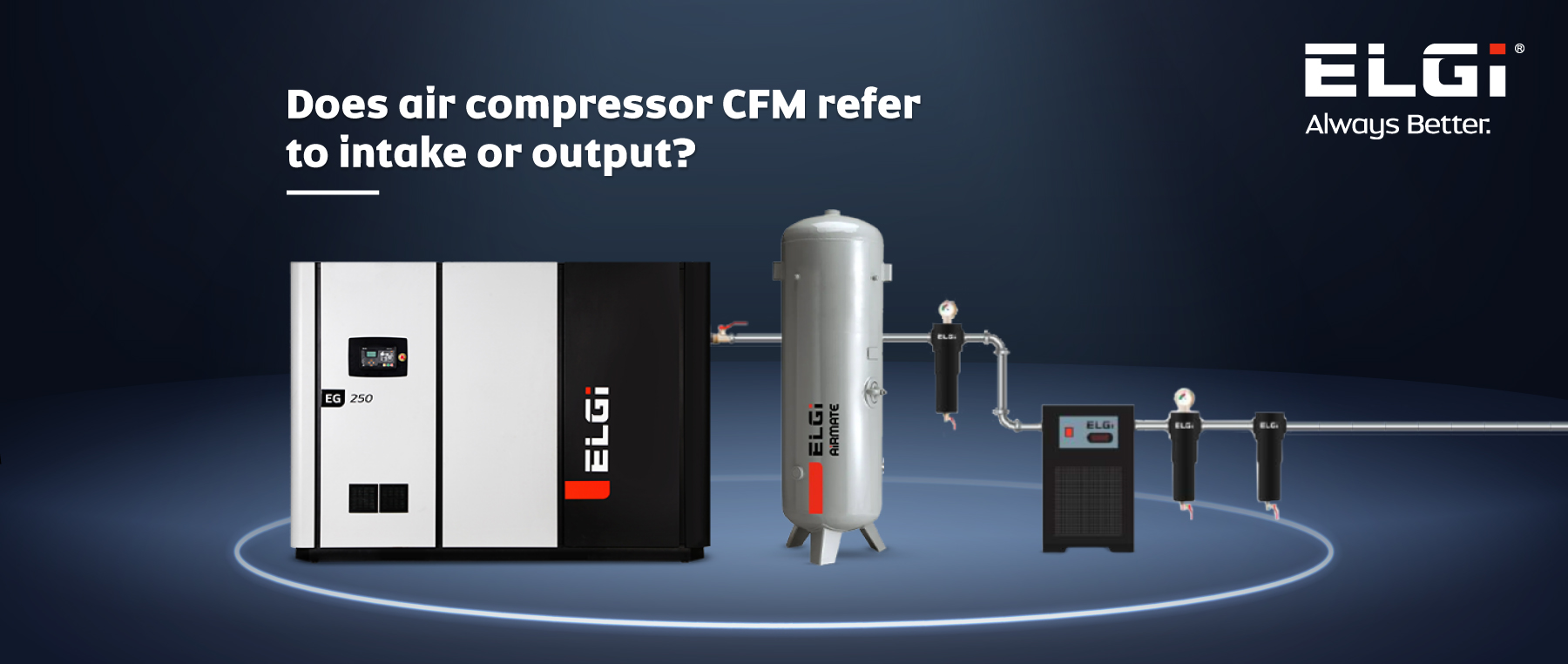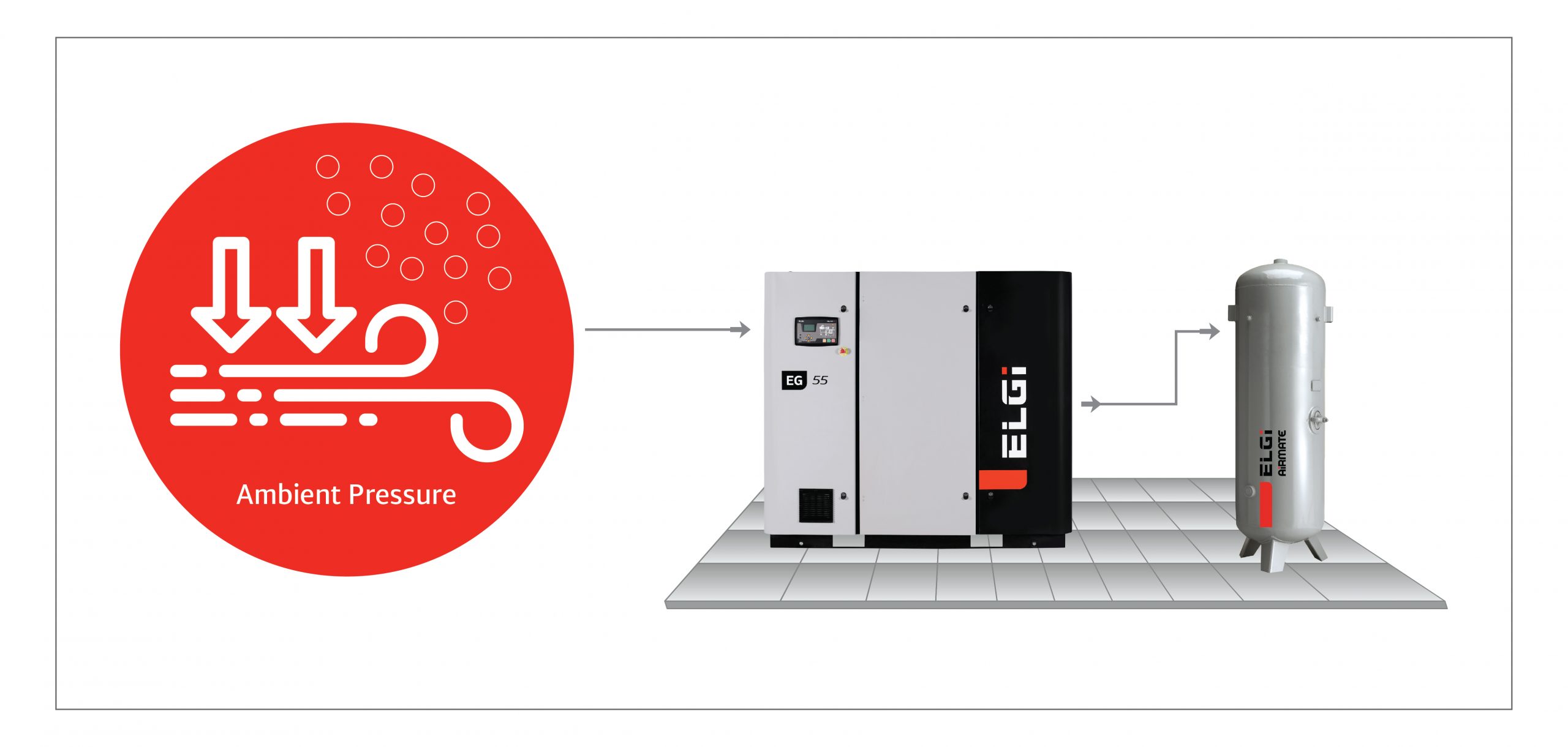Does air compressor CFM refer to intake or output?

CFM vs FAD:
Ever thought about how we conveniently call every photocopier "Xerox" and every portable music player "Walkman"? This is a phenomenon where a non-generic term is more popular than a generic term.
We do have something similar in the compressor industry. We often hear the word CFM mentioned by customers, designers, marketers, and other stakeholders in a sales pitch, product presentation, or design review. CFM is expanded as Cubic Feet per Minute (CFM). The CFM they talk about is Free Air Delivery (FAD) and not the unit of measurement.
FAD is the actual volume of compressed air delivered by the compressor at Delivery while considering the Suction conditions of the free air taken in. It is the volume of free air drawn at atmospheric conditions by the compressor, compressed and delivered at a specific pressure. CFM being the imperial unit of Measure of FAD is quite often understood as a FAD. Let us now try to understand the measurement of FAD.
CFM - The imperial unit:
CFM is the imperial unit of measurement of the compressor Free Air Delivery (FAD). There are also other units such as lpm in the SI system, m3/min (in some markets), etc.
FAD Measurement at Actual, Normal, and Standard conditions:
FAD measurement is commonly misunderstood as plugging a flow meter in the discharge side of the compressor, whereas the sensor which is fitted is calibrated to show the actual FAD of the compressor referring to the inlet conditions. An interesting thing about FAD measurement is that it is subject to change, considering ambient conditions. When a compressor is validated at the ELGi factory (Coimbatore, India), the validation expert measures the FAD at Coimbatore ambient conditions (38 °C, 1 bar). The measured FAD is known as Actual FAD (acfm). But, for a customer using the compressor in an end application point situated at Charlotte, the acfm value makes better sense when converted to a set of reference conditions. There are two commonly used reference conditions, namely standard conditions. When acfm is converted to standard reference conditions, the FAD is measured as Standard Cubic Feet per Minute (scfm) or Sm3/min. Similarly, when acfm is converted to normal reference conditions, the FAD is measured as normal Cubic Feet per Minute (ncfm) or Nm3/min.
Standard reference conditions:
Standard reference temperature = 20°C (68°F)
Standard reference pressure = 14.7psi (1.013bar)
Standard reference relative humidity = 36%
Normal reference conditions:
Normal reference temperature = 0°C (32°F)
Normal reference pressure = 14.7psi (1.013bar)
Normal reference Relative Humidity = 0%.
Significance of Normal/Standard vs Actual FAD when sizing a centrifugal compressor:
A centrifugal compressor is a non-positive displacement (or) dynamic compressor. They are different from a positive displacement compressor which works at a constant flow. Dynamic compressor work at constant pressure and the performance is affected by ambient conditions such as changes in inlet temperature, Mean Sea Level (MSL), Relative humidity, etc. Hence when conditions change, the FAD changes, and hence the ability to do work on a pneumatic tool or actuator increases or decreases with those changes. So, the conversion from acfm (m3/min) to scfm (Sm3/min) is critical when sizing a centrifugal compressor.
The debate between intake or output:
- Empirical formula method:
Ideal gas law:
The ideal gas law is represented by the following formula,
PV=nRT
where P - pressure
V – volume
T – Temperature
n, R - constants
The formula for FAD is merely a variation of the Ideal Gas law. The FAD formula contains three parameters such as pressure, temperature, and volume of the air at suction and discharge. The formula is represented as follows,
![]()
Volume and volumetric flow rate are proportional, hence can be interchanged in the equation. The usage of both input and output parameters establishes the fact that FAD measurement is not based on the point of measurement but rather a combination of both.
Illustration: A lubricated screw compressor is compressing ambient air at 140cfm, 1bar to compressed air at 20 cfm, 7bar. The actual discharge end volumetric flow rate is 20 cfm, provided we assume the inter-lobe losses to be net zero, which is an ideal condition assumption. This is validated by a technician using the nozzle method of flow measurement. Even though the C-D nozzle is fixed in the discharge end, the FAD calculated is referred to intake conditions, which means the header pipe from the discharge end contains compressed air at 7 bar and when the end user taps the pneumatic line, the air flows through the application which is at atmospheric conditions, thereby providing the customer the rated FAD.
- The ISO methodology:
The International Organization for Standards (ISO) describes the acceptance test for displacement compressors under ISO 1217. Clause 3.4.1 of ISO 1217 states:
“Actual volume flow rate of a compressor is the actual volume flow rate of gas, compressed and delivered at the standard discharge point, referred to conditions of total temperature, total pressure and composition prevailing at the standard inlet point.”
Section 6.2 has laid out “thirteen parameters” whose fluctuations can be moving the needle haphazardly while measuring FAD. These parameters are measured using sensors at the Suction and Discharge side as well as depending on the gas properties and the prime mover. Based on this, one can conclude that FAD measurement is not dependent on the point of measurement but rather a scientific application of inlet/outlet parameters to arrive at a meaningful flow parameter. The ISO method is seconding the conclusion drawn from the empirical formula method.

Conclusion:
Whenever someone raises the question, "Does air compressor CFM refer to intake or output?", we can confidently answer that FAD is a flow parameter of an air compressor that can be derived using both Suction and Discharge parameters, and it is not a parameter dependent on the point of measurement. FAD is the quantity of compressed air measured at discharge, converted back to inlet conditions of the compressor.








